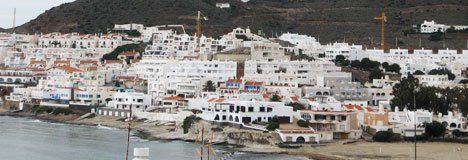AT the end of October, Madrid made an announcement of a radical change in the policy that has seen Spain’s coast become saturated in concrete.
Since the 1960s – when international tourism in Spain gained huge popularity – hotels, apartment blocks and homes went up at an alarming rate to satisfy the demand of the millions of visitors who come to the country each year.
Coastal construction has not slowed in the intervening 40 years with 260,000 hectares of littoral replaced by bricks, mortar and glass between 2000 and 2005, according to figures released by government think tank the Observatory for Sustainability in Spain.
In its manifesto for change – called the Strategy for Coastal Sustainability – the government wants to rid 800 kilometres of coast of constructions illegally erected after the Coast Law of 1988.
This means thousands of homes, hotels, plastic greenhouses and even swimming pools built on Spain’s sands and 100 metres inland face demolition.
At the moment, this move is nothing more than a statement of intent, as the government needs the support of town halls and authorities in Spain’s coastal regions to push the measure through – something that is easier said than done when you consider the nature of politics in Spain.
Traditionally, the opposition opposes everything the government says and does. Today, the socialists are in charge and the conservatives are in the shadows. However, the conservatives run many of the town halls, whose backing Madrid needs for this to be a success.
Below are just some of the plans the government has for Andalucía if its sustainability scheme comes to fruition.
Cádiz is the only province in Spain to have two different seas blessing its golden shores – the Atlantic Ocean and the Mediterranean Sea.
It is also the only province in Spain to have a satellite permanently fixed upon it in the look out for modern day pirates, who trawl its waters looking for sunken treasure.
For many years, the beaches of Cádiz were – relatively – free from the rampant model of construction witnessed further east in Málaga, Granada and Almería.
Today, however, many parts of its coastline are a “carbon copy of Marbella” (see below).
Little under 32 per cent of its 272-kilometre stretch of coastline is built up. The government fears this figure would be higher were it not for the fact the province has nine areas of its coastline protected.
But still, in the words of the province’s environment chief, “the situation is so out of control that the very survival of Cadiz’s coast is under threat from irreversible destruction.”
For out of control, you maybe could read Chiclana. Construction in the town has been under the judicial microscope for a number of years as the construction of 40,000 new homes has been suspended. As one environmentalist claimed: “Chiclana is a true disaster. There are around 25,000 illegal homes in the municipality, many of which do not have electricity or an adequate sewage system.”
On a smaller scale, constructions in Vejer de la Frontera and Conil also face demolition.

The Costa del Sol is a 200-kilometre stretch of concrete and glass. In describing the coast of Málaga, the government could not have been more damning.
And the figures back Madrid up. Almost 51 per cent of the first kilometre inland is built up while in some parts of the coast, famous for cheap package holidays, construction kisses the water of the Mediterranean – a sea that is predicted to rise by as much as half a metre by the end of this century.
There are more than 1,000 chiringuitos, beach restaurants famous for fried, fresh fish, on the sands of the province’s beaches. These will have to come down under the government’s plan.
As will the luxury villa of Hollywood actor Antonio Banderas, which was allegedly built upon public land in Marbella.
Also in this glitziest of towns, 240 homes in the Banana Beach complex (some of which are still being offered for sale on the Internet) will be demolished.
All in all, the 26 kilometres of littoral in Marbella have been “maltreated,” making it “almost impossible” for the government to rectify the instability of the sands.
The Costa del Sol’s litany of construction crimes continues in Manilva, where beach front campsites have either been closed down or they are in the process of being. Here, this small town of 11,000 has doubled its population since 2002.
In Estepona, the Rada Hotel is set to be demolished before the end of the year. Sitting on public land, the tourist complex has never opened for business.
Granada may only have 81 kilometres of coastline, but that has not spared it from uncontrollable development nor the government’s proposed clean up policy.
At the border with Málaga stands the protected, dramatic Maro-Cerro Gordo Natural Park. With its pine trees that reach the shore, quiet beaches and oft-sighted ibex goat, critics claim part of the protected land has been “illegally” privatised for a housing development.
In Almuñecar, the government would like to rid the town, whose population has grown 18 per cent in five years, of two hotels that invade the beaches at el Pozuelo and Playa Capitán.
There will also be moves to restore the coast to a more natural state at Punta de la Mona, Herradura, Marina del Este, Peñon de Lobo, Playa del Muerto and Playa Cabria.
All in all, the Costa Tropical resort has the highest number of coastal infractions along Granada’s modest coast.
Further east at Salobreña, officials are keeping a keen eye on the new PGOU urban expansion plan, which intends to make provisions for new hotels and homes in the small resort.
Then in nearby Motril, the new sustainability policy will seek to protect the cliffs at the Sacratiff cape.
Onwards, beaches will be returned to a natural state and the Granada coast will be rid of plastic greenhouses, which in some cases reach the sea.
Next, we reach Almería, where constructor’s cranes compete for space with the plastic of agriculturists.
According to the Strategy for Coastal Sustainability, here you find “a rapid deterioration of the natural conditions that define the littoral of Almería – a deterioration that is in a lot of cases irreversible or difficult to correct.”
The government has highlighted 18 black spots along the coastline, including a proposed 145,000 new homes in Almazora, a population of 11,000. Remember, this municipality is close to Palomares, upon which the US mistakenly dropped a few A-bombs 41 years ago.
There will be plans to dismantle plastic greenhouses, especially between Albufera Nueva and Playa de la Habana in the municipality of Roquetas.
In the same town, homes in Garrofa and on the beach at Zapillo and Punta del Río face demolition.
Several beaches will also be restored to a more natural state.
Nearby in Enix, hotels and apartment blocks will be knocked down while in the protected park of Cabo de Gata, which enjoys some of the most stunning scenery in Spain, beaches will be returned to a more “natural” state.
Also in this natural park, there are – according to central government – “degradations in the landscape at [popular resort] San José and a vast occupation of the littoral.”









I live in Chiclana and along with many others we buy a house using a lawyer, all is signed up with a notary you check the town plan and every one says its fine. Once you have parted with your life savings another story develops. This is a massive fraud. The notaries, lawyers and politicians will have to pay – people are getting very angry here in Chiclana.
OP say “apartment blocks and homes went up at an alarming rate to satisfy the demand of the millions of visitors who come to the country each year.”
So what? If there is demand then that does not mean you destroy your coastline to meet demand. The coastline and waters are more important than demand, so stuff demand and concentrate on the environment first. Look at it now – looks great right? What a mess.
Hey there West of Malaga!
Everyone needs to join up to fight against urban and legal abuses. There is a new collective way forward. Let’s hear from you!
For those west of Malaga ring 951 321 400 or 620 10 28 50 for details Christine A. Ferguson
The EUSSR could have saved much of the Med coastline from destruction.
Don’t forget that the EUSSR was set up in 1956, way before mass tourism took off.
How could they have done this – by making it compulsory for all EUSSR states to stagger their annual holidays.
So instead of millions all heading off for annual holiday in July/August, this could have been staggered from say April to end of October – too simple – too easy.
I used to be very pro EU but I see clearly that it’s only real function is too be a tool for big business to make more money – the USSR is dead – long live the EUSSR.